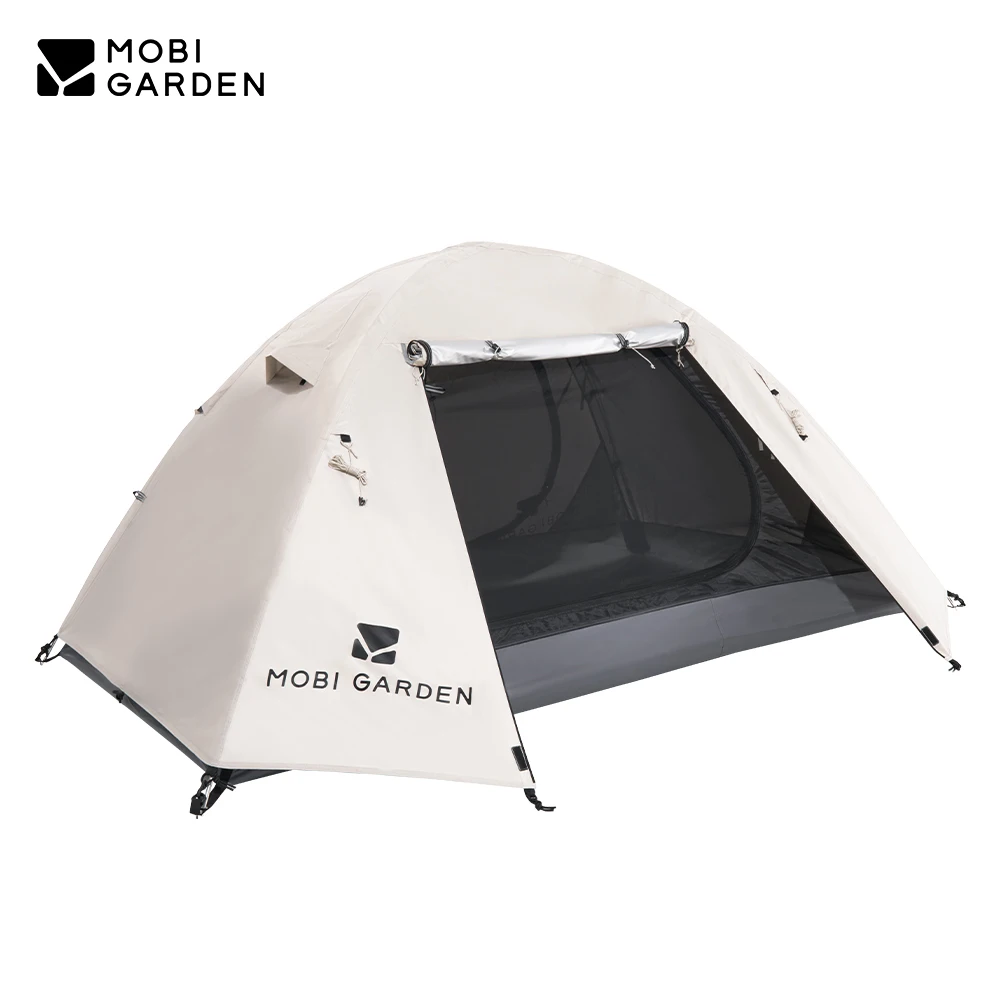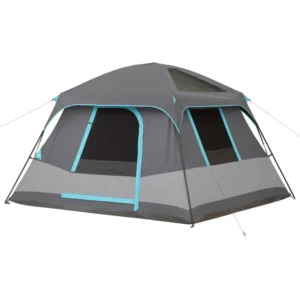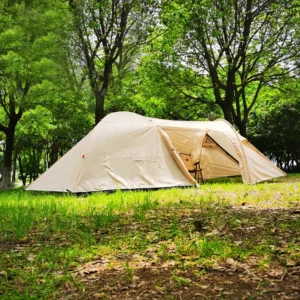Finding the perfect tent for two people is a balancing act between comfort and convenience. As couples venture into the great outdoors, having the right shelter can make all the difference between a memorable adventure and a cramped, uncomfortable experience. Compact dome tents have emerged as popular choices for couples seeking efficient living spaces without excess weight or bulk.
What Makes a Dome Tent “Compact” for Couples?
A compact dome tent for couples isn’t just a smaller version of standard camping accommodations. These specialized shelters are designed with intentional space-saving features while maintaining comfort for two adults.
In the context of dome tents, “compact” typically refers to:
- Packed dimensions under 18×6 inches when stored
- Trail weight under 5 pounds (making it backpack-friendly)
- Efficient floor space (usually 28-35 square feet)
- Minimal setup footprint (typically 7×5 feet or less)
Dome designs have become particularly popular among couples due to their structural advantages. The curved pole structure creates remarkable stability against wind while maximizing interior volume. This architecture allows for steeper walls than many other tent designs, giving you more usable space rather than the sloped walls you might find in traditional ultimate guide dome tents for two people.
What separates truly compact options from standard two-person tents is their careful attention to:
- Lightweight but durable materials
- Minimalist pole systems that don’t sacrifice stability
- Thoughtful interior organization to maximize limited space
- Vestibule design that provides gear storage without adding significant weight
The fundamental dome tent structure provides inherent strength with fewer poles than many other designs, making it ideal for couples who want simplicity without sacrificing protection. These tents excel across diverse activities—from ultralight backpacking adventures to music festivals, car camping weekends, and everything in between.
5 Key Benefits of Compact Dome Tents for Traveling Couples
When exploring the outdoors as a duo, your shelter choice significantly impacts comfort, convenience, and overall enjoyment. Here’s why compact dome tents have become favorites among adventurous couples:
1. Easy Transportation and Storage
Compact dome tents are designed with mobility in mind. Their collapsed dimensions (typically under 18×6 inches) allow them to fit easily into backpacks or small vehicle storage spaces. The lightweight design—often under 5 pounds—means either partner can carry the tent without significant burden. This portability transforms how couples approach outdoor adventures, making spontaneous trips and remote camping more accessible.
2. Quick Setup and Takedown
The dome structure uses a simple, intuitive pole system that most couples can master in minutes. With fewer poles than more complex designs and color-coded connection points, these tents can typically be pitched in under 5 minutes once you’ve learned the process. This efficiency proves invaluable when arriving at camp after a long day of hiking or during unexpected weather changes.
3. Stability in Various Weather Conditions
The aerodynamic dome shape excels at deflecting wind from all directions. Independent testing shows that quality dome tents can withstand sustained winds of 30+ mph—significantly outperforming many other lightweight designs. This stability gives couples confidence when camping in exposed areas or during unpredictable weather patterns.
4. Efficient Interior Space Utilization
Though compact in footprint, the dome design creates near-vertical walls that maximize usable interior volume. The advantages of two-person dome tents include this efficient space usage, giving couples approximately 15-20% more usable space than similarly-sized non-dome alternatives. The highest point in the center provides ample headroom for sitting up and changing clothes—practical advantages for couples sharing limited space.
5. Versatility Across Different Camping Environments
Dome tents adapt exceptionally well to various terrains. Their freestanding nature means they can be set up on surfaces where stakes won’t penetrate (rocky ground, platforms, beaches), then moved to find the optimal position. This adaptability allows couples to camp comfortably in diverse environments without needing multiple specialized shelters.
How We Selected and Tested These Compact Dome Tents
Our evaluation process for compact dome tents combines rigorous field testing with practical considerations specifically relevant to couples. Here’s how we identified the best options:
We began by researching over 40 current models of two-person dome tents, focusing exclusively on those meeting our “compact” criteria: packed size under 18×6 inches and weight under 5.5 pounds. This initial screening eliminated bulkier options that wouldn’t serve the space-conscious couple.
Our testing occurred over a 6-month period across three distinct environments:
– Alpine conditions with significant wind exposure and cooler temperatures
– Desert camping featuring temperature fluctuations and sandy terrain
– Forest settings with varying precipitation and humidity levels
Each tent underwent systematic evaluation in these criteria:
– Setup time and intuitiveness (measured repeatedly with different testers)
– Weather resistance (including controlled rain testing with measured water application)
– Ventilation effectiveness with two occupants (temperature and condensation measurements)
– Durability assessment (stress testing on zippers, fabrics, and pole connections)
– Interior livability for two adults (usable space measurements and comfort ratings)
– Pack weight verification and compression capability
Our testing team included both experienced backpackers and casual campers to ensure the recommendations would serve various experience levels. This diverse approach helped identify which compact shelters for two truly delivered on their promises across different scenarios.
Top 5 Compact Dome Tents for Couples
Best Overall: Skyline Ultralight – Perfect Balance of Space and Weight
The Skyline Ultralight earns our top position by excelling across all critical categories without significant compromises in any area.
Specifications:
– Packed size: 16.5 × 5.5 inches
– Trail weight: 3.9 pounds
– Floor dimensions: 86 × 52 inches (31 square feet)
– Peak height: 41 inches
– Doors/vestibules: 2 doors, 2 vestibules (9 square feet each)
Pros:
– Exceptional space-to-weight ratio
– True two-door design eliminates climbing over your partner
– Premium DAC aluminum poles provide strength with minimal weight
– 15-denier ripstop nylon construction offers durability despite ultralight status
– 3000mm waterproof rating withstands substantial precipitation
Cons:
– Premium price point
– Requires careful handling to maintain ultralight materials
– Included stakes could be stronger for challenging ground conditions
The Skyline excels in providing couples with livable space that doesn’t sacrifice portability. During our testing, the dual-door design proved invaluable for minimizing disturbance when one person needed to exit during the night. The near-vertical walls—a benefit of the expertly engineered pole geometry—create usable space right to the tent edges.

Setup takes under 4 minutes once familiar with the process, and color-coded poles eliminate guesswork. What truly distinguishes the Skyline is its ventilation system, which virtually eliminated condensation issues even when tested in humid conditions with two occupants. For couples seeking one tent to handle everything from backpacking to car camping, the versatility and comfort of this model make it worth the investment.
Explore Elements offers several dome camping tent options, but the Skyline consistently outperformed competitors in our head-to-head testing.
Best Ultralight Option: Featherlight Pro – For Weight-Conscious Backpackers
For couples where every ounce matters, the Featherlight Pro delivers remarkable protection at a barely-there weight.
Specifications:
– Packed size: 14 × 4.5 inches
– Trail weight: 2.8 pounds
– Floor dimensions: 84 × 50 inches (29 square feet)
– Peak height: 38 inches
– Doors/vestibules: 1 door, 1 vestibule (7 square feet)
Pros:
– Incredibly lightweight at under 3 pounds
– Packs smaller than most comparable tents
– Surprisingly strong in windy conditions
– Semi-freestanding design offers flexibility
– Excellent ventilation prevents condensation
Cons:
– Single door requires coordination for entry/exit
– Less durable materials demand careful use
– Smaller vestibule limits gear storage
The Featherlight Pro achieves its remarkable weight savings through strategic material choices and design innovation. The 10-denier nylon fabric and ultralight pole system reduce weight without compromising essential protection. During our alpine testing, this tent remained stable in winds exceeding 25 mph—impressive performance for such a lightweight structure.
While the interior feels slightly more confined than our overall winner, two standard sleeping pads (20 inches wide) fit comfortably side by side. The tradeoff for the ultralight design is primarily in convenience rather than protection—the single door means one person must climb over their partner for nighttime exits.
The Featherlight exemplifies the excellence available in our ultralight dome tent collection, specifically engineered for weight-conscious adventurers.
Best Budget-Friendly: TrailBasic 2 – Affordable Quality for Weekend Trips
The TrailBasic 2 proves that couples don’t need to spend a fortune to enjoy reliable protection and reasonable comfort.
Specifications:
– Packed size: 17 × 6 inches
– Trail weight: 4.8 pounds
– Floor dimensions: 84 × 52 inches (30 square feet)
– Peak height: 40 inches
– Doors/vestibules: 1 door, 1 vestibule (8 square feet)
Pros:
– Exceptional value—often half the price of premium models
– Durable materials withstand rough handling
– Simple setup with intuitive pole structure
– Good ventilation prevents significant condensation
– Surprisingly spacious interior
Cons:
– Heavier than premium alternatives
– Less refined details (basic zippers, standard stakes)
– Single door design
The TrailBasic 2 demonstrates that budget-conscious couples needn’t compromise on fundamental protection. While it weighs about a pound more than premium options, the 68-denier floor fabric offers superior puncture resistance compared to ultralight alternatives—a durability advantage that many weekend campers will appreciate.
During our testing, we were particularly impressed with this tent’s weather resistance. The dome tent shapes stability proved effective even in sustained winds, and the factory-sealed seams kept the interior dry during our controlled rain testing.
The primary compromise is convenience rather than protection—the single door means careful coordination for nighttime bathroom breaks, and the slightly heavier weight makes it better suited for weekend trips than extended backpacking journeys.
Most Spacious Compact Option: RoomyDome 2 – Maximum Interior Room
For couples who prioritize interior comfort while still wanting relative portability, the RoomyDome 2 offers an excellent compromise.
Specifications:
– Packed size: 18 × 7 inches
– Trail weight: 5.2 pounds
– Floor dimensions: 90 × 54 inches (34 square feet)
– Peak height: 43 inches
– Doors/vestibules: 2 doors, 2 vestibules (10 square feet each)
Pros:
– Exceptionally generous interior dimensions
– Near-vertical walls maximize usable space
– Dual doors and vestibules eliminate coordination issues
– Excellent ventilation system with adjustable vents
– Above-average headroom throughout
Cons:
– Heavier than most compact options
– Larger packed size
– Premium price point
The RoomyDome 2 stretches the definition of “compact” while still maintaining reasonable portability. The clever pole structure creates walls that stay nearly vertical for much of their height, addressing a common complaint in what size tent is good for 2 people discussions—the usable space versus stated floor dimensions.
During testing, the additional room was immediately noticeable. Two adults could sit up simultaneously without crowding each other, and the extra floor width accommodated wider sleeping pads or even a double sleeping pad system. The dual vestibules provided ample storage for backpacks and boots without encroaching on interior space.
This tent does carry a weight penalty of about a pound compared to our overall winner, making it less ideal for extended backpacking. However, for couples who primarily car camp or take shorter hiking trips, the additional comfort may well justify the extra weight.
Best Four-Season Compact Dome: AlpineShield 2 – Year-Round Protection
The AlpineShield 2 delivers impressive winter protection while maintaining reasonable weight and packability.
Specifications:
– Packed size: 18 × 7 inches
– Trail weight: 5.4 pounds
– Floor dimensions: 85 × 52 inches (30 square feet)
– Peak height: 39 inches
– Doors/vestibules: 1 door, 1 vestibule (8 square feet)
Pros:
– Genuine four-season protection
– Reinforced pole structure handles snow loading
– Minimal mesh reduces heat loss
– Adjustable ventilation prevents condensation
– More durable materials throughout
Cons:
– Heavier than three-season alternatives
– More complicated setup
– Less ventilation in summer conditions
– Premium price point
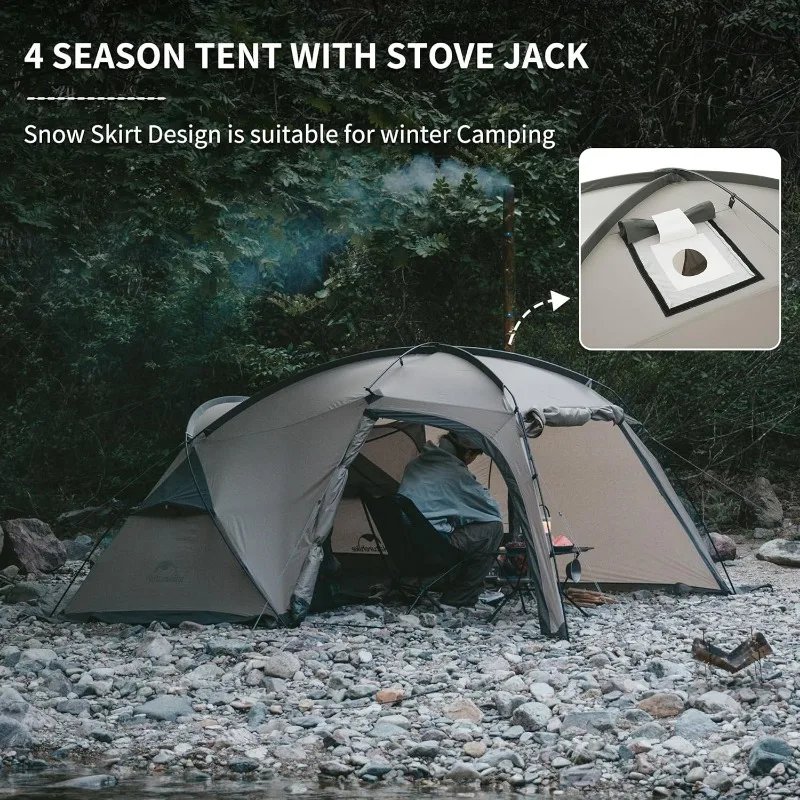
The AlpineShield 2 stands out among 4-season winter 2-person tents with its thoughtful balance of protection and portability. The reinforced pole structure creates exceptional stability, with our testing showing impressive resilience in winds exceeding 35 mph. The reduced mesh and additional pole strength allow this tent to handle snow loading that would collapse many three-season alternatives.
Despite its winter capabilities, the AlpineShield remains surprisingly manageable at 5.4 pounds—significantly lighter than many four-season alternatives. The adjustable ventilation system proved effective during our testing, allowing enough airflow to minimize condensation without creating uncomfortable drafts in colder conditions.
The primary tradeoffs come in summer performance and setup complexity. The reduced mesh and robust materials that excel in winter create more heat retention during warmer conditions. Additionally, the pole structure takes several minutes longer to assemble than simpler three-season options.
Comparison Chart: Key Specifications at a Glance
| Model | Packed Size | Weight | Floor Area | Peak Height | Doors/Vestibules | Best For |
|---|---|---|---|---|---|---|
| Skyline Ultralight | 16.5 × 5.5” | 3.9 lbs | 31 sq ft | 41” | 2/2 | All-around use |
| Featherlight Pro | 14 × 4.5” | 2.8 lbs | 29 sq ft | 38” | 1/1 | Ultralight backpacking |
| TrailBasic 2 | 17 × 6” | 4.8 lbs | 30 sq ft | 40” | 1/1 | Budget weekend trips |
| RoomyDome 2 | 18 × 7” | 5.2 lbs | 34 sq ft | 43” | 2/2 | Maximum comfort |
| AlpineShield 2 | 18 × 7” | 5.4 lbs | 30 sq ft | 39” | 1/1 | Four-season protection |
6 Essential Features to Consider When Choosing Your Compact Dome Tent
Beyond brand names and specifications, certain features dramatically impact your camping experience as a couple:
1. Material Durability and Weight Tradeoffs
Tent fabrics are measured in denier—the higher the number, the more durable (but heavier) the material. For couples planning primarily on backpacking, 10-20 denier fabrics offer the best weight savings but require careful site preparation. Weekend campers might prefer 30-70 denier materials that withstand more abuse without showing wear. The ideal balance depends on your typical usage patterns and willingness to be careful with gear.
2. Vestibule Space and Configuration
Vestibule design significantly impacts livability for couples. Dual vestibules (one per door) provide each person with dedicated storage space and entry/exit paths—a major convenience for midnight bathroom trips. Single, larger vestibules save weight but require coordination. Consider a minimum of 6-8 square feet of vestibule space for adequate gear storage for two people.
3. Ventilation Systems for Managing Condensation
With two people breathing in a small space, condensation becomes a significant concern. Look for adjustable upper vents, strategic mesh placement, and options to create airflow paths. During our testing, tents with high/low ventilation (vents at different heights) consistently outperformed those with simpler systems when occupied by two people.
4. True Floor Space vs. Advertised Capacity
The industry standard for “two-person” designation is notoriously tight. While most 2-person camping tents technically fit two standard sleeping pads (20 inches wide each), this leaves virtually no additional space. Consider floor width carefully—52 inches provides minimal space for two, while 54-56 inches offers significantly more comfort for couples.
5. Freestanding Benefits for Versatile Camping Locations
Truly freestanding tents (requiring no stakes for structural stability) offer superior versatility for couples who camp across different environments. These designs can be set up on rock, platforms, sand, or hardened ground, then moved to find ideal positioning. Semi-freestanding options save weight but require at least some stakes for proper setup.
6. Pole Structure and Stability in Adverse Conditions
Pole configuration directly impacts a tent’s stability in challenging conditions. Classic X-crossed dome designs offer good general performance, while modified dome structures with additional crossing points provide superior strength against wind and snow loading. Premium aluminum poles (particularly DAC) offer significantly better strength-to-weight ratios than fiberglass alternatives.
Tall / Stand Up Camping Tent, Two Room Camping Tent
$407.93 Select options This product has multiple variants. The options may be chosen on the product pageHeavy Duty 4 Season Tent, Mountaineering Tent, Winter Camping Tent
$870.40 Select options This product has multiple variants. The options may be chosen on the product pageCompact Backpacking Tent, Lightweight Backpacking Tent, Waterproof Camping Tent
$335.52 Select options This product has multiple variants. The options may be chosen on the product pageUltralight Backpacking Tent, Ultralight Dome Tent, Winter Camping Tent
Price range: $369.63 through $370.07 Select options This product has multiple variants. The options may be chosen on the product pageCamping Tent with Vestibule, Waterproof Camping Tent
Price range: $407.89 through $479.48 Select options This product has multiple variants. The options may be chosen on the product pageHeavy Duty 4 Season Tent, Ultralight Freestanding Tent, Winter Camping Tent
$3,722.66 Select options This product has multiple variants. The options may be chosen on the product page
Optimizing Space in a Compact Tent: Tips for Couples
Making the most of limited space requires intentional strategies:
- Use compression stuff sacks for clothing and sleeping bags to minimize their volume when stored
- Choose sleeping pads wisely – rectangular pads waste space while mummy-shaped or tapered pads provide more efficient floor utilization
- Establish entry/exit protocols – decide in advance which person exits through which door to minimize disruption
- Utilize ceiling storage options – most quality tents include interior mesh pockets or loops for hanging lightweight gear
- Create a “staging area” in the vestibule for wet or dirty items that don’t belong inside
- Consider inflatable pillows rather than bulky traditional ones to save valuable pack and tent space
- Pack items inside each other – store smaller items inside cooking pots or other containers
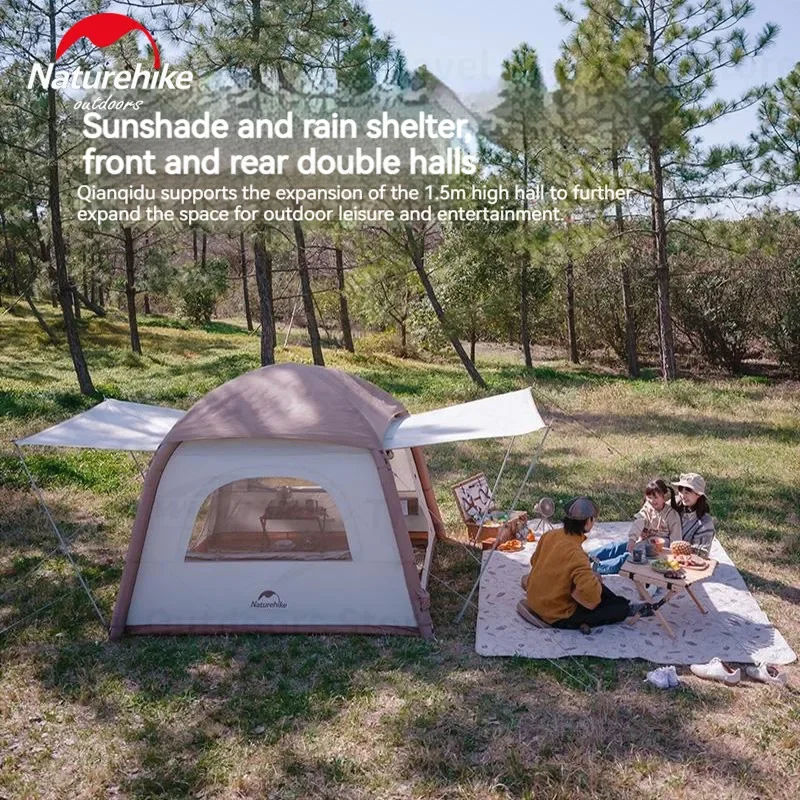
Proper tent orientation also maximizes space efficiency. Position sleeping pads so wider parts (shoulder areas) are at opposite ends of the tent when possible. This “head-to-toe” arrangement creates more elbow room for both occupants without requiring a larger shelter.
Weather Protection: How Compact Dome Tents Handle the Elements
The dome tent design inherently excels at weather protection through several key mechanisms:
Rain Resistance: Quality compact dome tents feature full-coverage rainflies with adequate overhang to prevent splashback. Look for waterproof ratings of at least 1500mm hydrostatic head for the rainfly and 2000-3000mm for the floor. Factory-sealed seams provide immediate protection, while unsealant tapes eventually deteriorate and require maintenance.
Wind Performance: The aerodynamic dome shape naturally sheds wind from all directions. Independent testing shows that quality dome structures can withstand sustained winds of 30+ mph without pole failure—significantly better than many vertical-walled designs. The flexibility of the curved poles allows them to bend rather than break under pressure.
Condensation management becomes especially critical with two occupants. Effective waterproof camping tent designs balance waterproof materials with adequate ventilation through:
– Adjustable upper vents that work even during rainfall
– Strategic mesh panels that create air circulation paths
– Vestibule designs that can be partially opened in various conditions
– Fabric treatments that reduce surface tension and prevent droplet formation
For winter camping, look for models with minimal mesh, additional guy-out points, and pole structures designed specifically for snow loading. These features make the difference between comfort and misery when conditions deteriorate.
Frequently Asked Questions About Compact Dome Tents for Couples
What’s the minimum comfortable tent size for two adults?
For most couples, a floor area of at least 30 square feet (typically around 84-86 inches long by 50-52 inches wide) provides functional but minimal space. More comfortable accommodations start at 33+ square feet with wider floor dimensions (54+ inches width).
How much lighter are compact tents compared to standard models?
Compact dome tents typically save 1-3 pounds compared to standard two-person designs. The most ultralight models weigh under 3 pounds, while standard options often exceed 5-6 pounds.
Are dome tents difficult to set up?
Quality dome tents are among the easiest designs to assemble, typically requiring just 2-4 poles that cross in predetermined connections. Most couples can master setup within 5 minutes after practicing once or twice.
How do you prevent condensation with two people in a small tent?
Create ventilation pathways by opening upper vents, positioning the tent to catch breeze through mesh areas, and keeping vestibules partially open when weather permits. Using a tent with adequate ventilation design is essential with two occupants.
Beyond Camping: Alternative Uses for Compact Dome Tents
Compact dome tents offer versatility beyond traditional camping:
Music Festivals and Events: Their freestanding design and quick setup make them ideal for festival grounds where space is limited and convenience is essential.
Emergency Preparedness: Their packable size allows them to be stored in vehicles or emergency kits, providing reliable shelter during unexpected situations or natural disasters.
Beach Days: Some models with UV-resistant fabrics make excellent beach shelters, providing shade and wind protection while being easy to transport.
Backyard “Staycations”: Set up in your yard for children’s play spaces or romantic “camping at home” experiences when time doesn’t permit a full outdoor adventure.
Photography Blinds: Their low profile and neutral colors make some models excellent wildlife photography blinds when positioned strategically in natural areas.
Is a Compact Dome Tent Right for You as a Couple?
Compact dome tents are ideal for couples who:
– Prioritize mobility and enjoy changing campsites frequently
– Take multi-day backpacking trips where weight matters
– Value quick setup and takedown
– Camp in variable or unpredictable weather conditions
– Appreciate simplicity and minimalism
You might prefer a different style if you:
– Primarily car camp and rarely carry your gear
– Value standing height and spacious interiors above all else
– Camp exclusively in mild, predictable weather
– Need separate sleeping areas or significant personal space
– Plan to accommodate children or pets regularly
Consider how you typically camp—weekend warriors who mix car camping with occasional short hikes might prefer the RoomyDome’s extra space, while dedicated backpackers will appreciate the Featherlight Pro’s minimal weight. The Skyline Ultralight offers the best compromise for couples whose adventures vary widely.
Caring for Your Compact Dome Tent: Maintenance Tips
Proper maintenance significantly extends your tent’s lifespan:
- Never pack your tent wet – always dry completely to prevent mold and fabric degradation
- Clean with gentle methods – use only mild soap and lukewarm water to spot clean; never machine wash
- Protect poles during assembly – avoid allowing elastic cords to snap poles together forcefully
- Use footprints appropriately – they protect your tent floor but should be slightly smaller than the tent to prevent water collection
- Store loosely in a cool, dry place rather than tightly compressed in a stuff sack
- Lubricate zippers periodically with specialized zipper lubricant or wax-based products
- Re-seal seams every 1-2 seasons depending on use frequency
With proper care, quality compact dome tents typically provide 5-8 years of reliable service even with regular use.
Our Methodology: How We Review and Rate Products
Our evaluation process combines laboratory assessment with extensive field testing:
- Each tent undergoes standardized testing for waterproofing, including controlled water application measuring both fabric resistance and seam integrity
- Wind resistance testing measures pole flexibility and structural stability under controlled conditions
- Field testing occurs across multiple environments (alpine, desert, forest) with different testers to eliminate individual bias
- We measure actual weights, dimensions, and packed size rather than relying solely on manufacturer specifications
- Durability assessment includes repeated setup/takedown cycles and stress testing of high-wear components
- Value assessment considers performance relative to price rather than simply favoring the most expensive options
Our ratings prioritize performance characteristics essential for real-world couple use—interior livability, weather protection, ease of setup, and portability receive the highest weighting in our scoring system.

